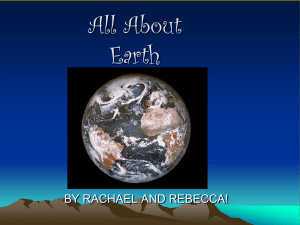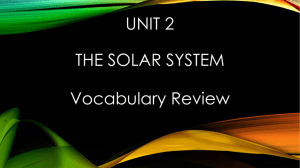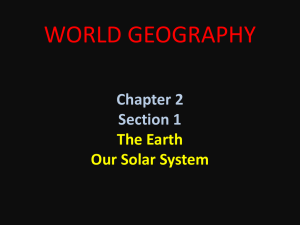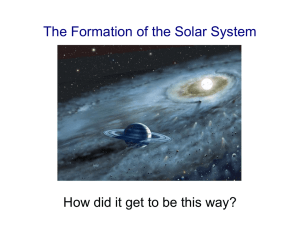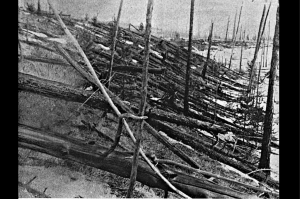Unit 3 - Section 9.5 Solar Nebula Theory
advertisement
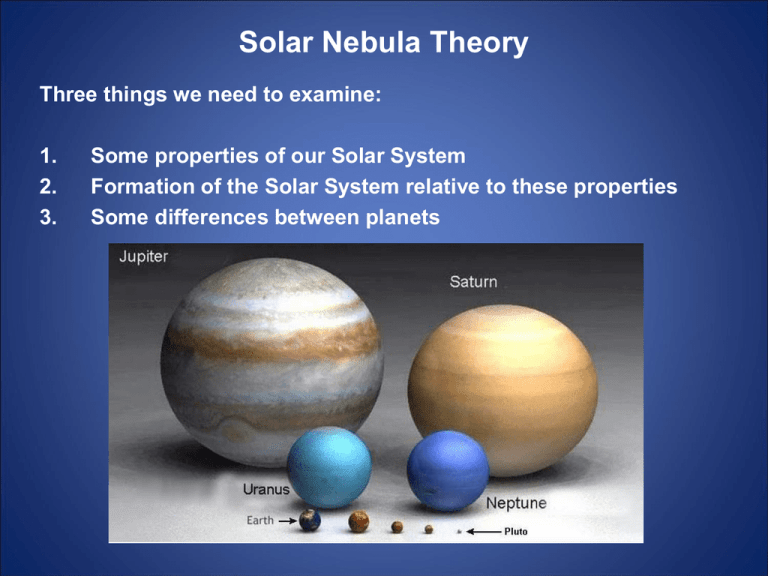
Solar Nebula Theory Three things we need to examine: 1. 2. 3. Some properties of our Solar System Formation of the Solar System relative to these properties Some differences between planets Solar Nebula Theory Recall the Solar System scale… 1. 2. 3. 4. 5. The distance from the Sun to Earth is 1.5 X 108 km or 1 Astronomical Unit (AU). From the Sun to the dwarf planet Pluto is 40 AU Presently, we cannot fly people to Mars…our closest neighbour planet The Sun is 98% of the mass of the Solar System. If the Sun were a basketball, Mercury would be a tiny, tiny ball bearing and a large asteroid would be a speck of dust Jupiter is 318X larger than Earth Solar Nebula Theory Some New Stuff… All objects in the Solar System are about 4.6 billion years old. We know this from radioactive dating. For example, the Half-Life of U238 is 4.5 billion years. Oldest Earth rocks at 3.96 billion years old. If we radioactive date a planet, we are actually looking at the time the mass solidified. Thus, the Solar System is much older that 4.6 billion years Solar Nebula Theory Formation of the Solar System The Solar System formed from the collapse of a cloud of gas and dust. The cloud was slowing rotating and formed a shape of a disk from centrifugal forces. This process moved matter to its centre Conservation of Angular Momentum (…recall that…) made the rotation faster. As well, the disk began rotating along one plane. This rotational pattern explains why most of the planets orbit in the same direction and along the same plane (see illustration). Solar Nebula Theory Formation of the Solar System…2 Dust , rock and ice joined to make small planetesimal bodies This is the start of planet building Via gravitational pull, larger planetesimals attract smaller ones. They collide and possibly merge to form larger bodies…eventually planets The Sun is burning very hot. The heat prevents the formation of atmospheres in the closest planets. Solar Nebula Theory Formation of the Solar System…3 The planets are mostly liquid-like. Heavy elements start to sink , and as a result, radioactive elements are concentrated in the centre. NOTE: This explains the intense heat at the Earth’s core AND gravitational energy. On Earth, gases such as H2S, SO2, CO2, H2O, NH3 and N2 are released from the hot interior. These gases react with solar radiation to break apart and form rudimentary atmospheres. This explains the Inner Planets which are terrestrial. How might the process differ for the Outer or Gas Planets? Solar Nebula Theory • This idea for planet formation was originally proposed by Immanuel Kent in 1755. Kent thought a NEBULAE (huge cloud of dust and gas) was pulled together by gravity so that it collapsed into a flat, rotating disk. As suggested, increased gravitational and centrifugal forces from spinning and rotating caused the disk to coalesced into the Sun and planets. • Is this correct? If so, should the Sun not have most of the motion caused by gravitational forces….hmmm? Solar Nebulae Theory Modified, the new hypothesis states (1) a nebulae rotates and collapses to form a solar system, (2) instabilities cause dust particles to stick together (planetesimals), (3) these particles collide and form protoplanets, (4) the centre of the disk becomes so massive and hot it “turns on” (i.e., Sun) and (5) the Sun radiates energy that vaporizes dust in the inner Solar System. Solar Nebula Theory • This updated idea still did not explain lack of Sun momentum. • Turns out, the Sun is magnetic. The momentum of the Sun is offset (…slowed…) by the counteracting magnetic force, AND the force of the Sun’s spin is transferred to the planets so all angular momentum resides with the planets

